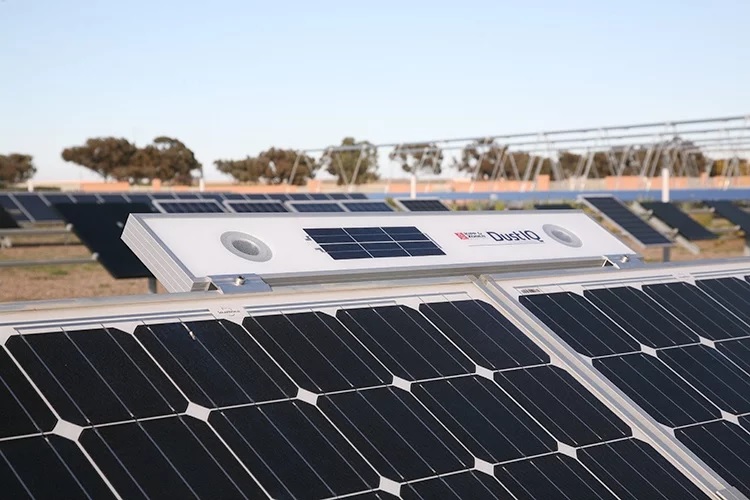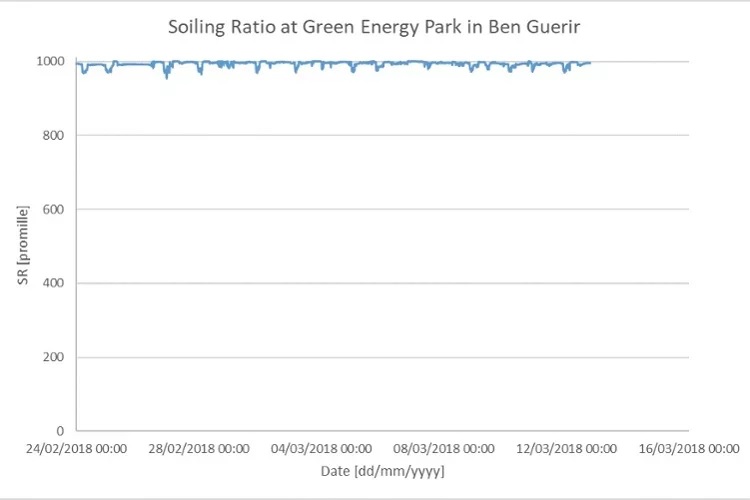One month ago, on valentine’s day, I got up at 4 in the morning. Not to surprise my wife with a breakfast but to catch a flight to Marrakesh in Morocco to visit the Green Energy Park of IRESEN (Research Institute for Solar Energy and New Energies). With me I brought two new DustIQ’s PV soiling monitoring systems for testing by Dr. Ahmed Alami Merrouni at this excellent site.
When I arrived we started with a tour of the many facilities for concentrated solar power (CSP) and photovoltaic (PV) solar research. Along the way I saw an uncleaned CSP linear Fresnel reflector mirror that showed a lot of accumulated soiling. A good sign of the potential for soiling research at this site!
The facility also has a top of the line solar monitoring station with a Kipp & Zonen SOLYS sun tracker, pyranometers, pyrheliometers and the TraCS system to measure soiling on a mirror surface perpendicular to the sun.
DustIQ soiling measurement system
3 big factors (apart from hardware aspects) determine the PV park performance: irradiance, temperature and soiling. For measurement of soiling Kipp & Zonen has developed the unique DustIQ soiling monitoring system. The next day we started with the installation of the two DustIQ systems, the RT1 smart rooftop monitoring system and the logging systems for the instruments as well as for the PV modules.
The DustIQ monitors the Soiling Ratio (SR) and for comparison at solar noon we mounted each DustIQ above a pair of PV modules. One of the PV modules is cleaned on a regular interval, as a reference, and the other PV module is not cleaned and accumulates dust. The ratio of the short circuit current of the clean and uncleaned PV module is used to determine the SR and can be compared with the DustIQ.
The feedback about the DustIQ installation is that it is very easy to install compared to other soiling systems. Furthermore it can be installed at any location in the PV park.A very nice feature of the DustIQ is that it does not require any cleaning to make a measurement of the soiling, unlike other soiling systems.
RT1 Rooftop sensor
Alongside the DustIQ we also installed the RT1, to measure the plane of array (POA) irradiance. It also comes with a back panel temperature sensor that allows you to measure the temperature of the PV module. This enables you to determine 2 other factors that determine the PV performance: irradiance and temperature. RT1 is designed for commercial rooftop PV installations. Like DustIQ, installation is very easy and requires no additional tools or parts because it can be mounted directly onto the panel.
Collaboration and first data from Ahmed
On Friday I left the Green Energy Park in Ben Guerir and said goodbye for now to Ahmed. I am very grateful for the warm welcome I had from him and the other people at Green Energy park. And I welcome any further collaboration with Ahmed.
In the mean time first data from the DustIQ was sent by Ahmed and shows a stable operation.
The dry season with soiling has not started yet so we do not measure a lot of soiling yet. At night time and in the early hours of the day at this time of year there is some dew on the panels. This dew dries up quickly during daylight but it generates a small signal on the DustIQ, which you can see in the figure.
Written by Marc Korevaar, Scientist Kipp & Zonen




